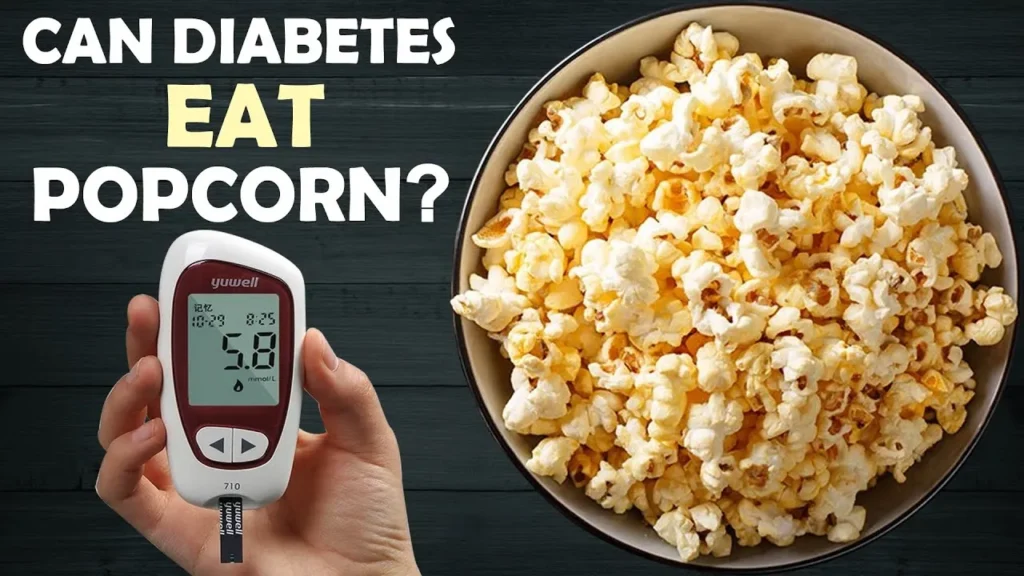This article explores the answer to the question: Is popcorn good for diabetes people? Popcorn is a favourite snack among many millions worldwide. Light, crunchy, and flammable in a never-ending variety of ways, it is a great snack for many people. Unfortunately, for those who have diabetes, choosing the right snack is a decision to make in order to maintain proper blood sugar levels.
Understanding Diabetes and Diet
What is Diabetes?
Diabetes is a chronic medical condition that affects the body’s ability to process blood sugar. There are two main types of diabetes: Type 1 and Type 2. In type 1 diabetes, a person’s body does not produce insulin—a hormone that enables sugar to get into the body’s cells to produce energy. Type 2 diabetes is much more common and is caused by either the body resisting insulin or the inability of the body to produce enough insulin to result in normal blood sugar levels.
One of these management methods is through carbohydrate control, as they have the most direct effect on blood sugar levels. As such, it becomes essential for a person with diabetes to have food nutritive knowledge even for snacks such as popcorn.
Implications of the Knowledge of Food Nutrition: Popcorn in Diabetic Diet
A diabetes-friendly diet is about managing blood sugar levels by rationing the amount of carbohydrates, fats, and sugars that one consumes at the same time, making sure that one gets adequate nutrition. This diet usually involves whole grains, lean proteins, healthy fats, and lots of fruits and vegetables. In general, snacks that are low in sugar content and high in fibre, with energy that keeps you going, are better than snacks that will elevate your blood sugar.
Nutritional Value of Popcorn
Popcorn is a whole grain. It’s a type of corn kernel that expands when heated. Being a whole grain means that it contains all parts of the grain—the bran, germ, and endosperm. Thus, popcorn can be quite rich in calories for a small snack.
Macronutrient Breakdown
A standard serving of air-popped popcorn (about 3 cups) contains:
Calories: Approximately 93 calories
Carbohydrates: 18.6 grams
Dietary Fiber: 3.6 grams
Protein: 3 grams
Fat: 1.1 grams
Vitamins and Minerals
Popcorn also contains small amounts of various other bioactive important vitamins and minerals, such as:
Magnesium: This is very important for blood sugar control and insulin sensitivity.
Phosphorus: This mineral plays an important role in maintaining healthy bones and generating energy.
Zinc: Necessary for immune function, zinc is also a part of processes for wound healing.
The B Vitamins: Including thiamine, niacin, and B6—popcorn is also associated with energy metabolism.
Antioxidants: Popcorn has polyphenolic compounds that exercise antioxidant capabilities in combating oxidative stress.
Glycemic Index and Load
The GI is therefore a scale for rating foods with carbohydrates by the resulting effects they have on the levels of blood glucose. High GI foods cause a large increase in blood sugar and a rapid elevation; low GI foods show only a small and gradual increase.
Glycemic Index Rating: Popcorn has a GI of around 55, which is in the medium range. Therefore, blood sugar levels will rise only moderately in response to it compared to what transpires with white bread or sugary snacks, which are high in their GI ratings.
Glycemic Load: It also takes into account the GI of a food in addition to what its portion size is, resulting in better information with regard to its influence on blood sugars. Air-popped popcorn has a GL of about 7, which is low, so its effect on blood sugar is in the middle of the road.

Benefits of Popcorn for Diabetics
- Low in Calories and Filling: Popcorn is really low in energy density and very filling owing to its high volume. Therefore, it may assist one in weight management, which is part and parcel of diabetes management, without further thought about the weight burden. In addition, the copious amount of fibre inside it gives one satiety, which will consequently prevent overeating.
- Popcorn is classified as a whole grain because it has all the different basic nutrients and fibers that a body needs. It has fiber contents that help prevent the sudden absorption of sugar into the bloodstream, thus keeping the rate of blood glucose in a stable rate.
- Low Glycemic Load: The low glycemic load contained in popcorn makes it a far better snack than any other high-carbohydrate snacks that are likely to result in higher blood sugar peaks.
- Easy to Serve and Versatile: There are many ways to prepare and serve popcorn, making it versatile in use. Healthier versions can be made with how popcorn is popped and the amount of added fat and sugars.
Concerns and Cautions to mind
Portion Control: A low energy food, popcorn’s portion size is still important, especially for those individuals living with diabetes. Overly large portions can impart too much carbohydrate and may affect one’s blood glucose levels.
Added Ingredients: Pre-packaged or flavored popcorn often has loads of sugars, unhealthy fats, and too much salt, not to the best of health. Be sure to buy plain, air-popped popcorn—or better yet, make your own.
Individual Variations: The effects of different types of food on blood sugar levels can vary from one person to another. The rise in the levels of blood sugar may be far more for a diabetic as compared to any other person. The mantra is to find out about the effect of popcorn on your blood sugar.
Making Popcorn Diabetes-Friendly: Good Practices
Enjoy delicious popcorn, suitable for people suffering from diabetes, in the following ways:
1. Air-Popped Popcorn
Air-popped popcorn is the healthiest choice. It contains the fewest calories and no added fats, sugars, or artificial ingredients. Prepare air-popped popcorn at home by using a popcorn machine, or simply microwave plain kernels in a paper bag to engineer it yourself.
2. Be Mindful of Portion Sizes
Keep your portion to a serving size of approximately 3 cups of the air-popped variety, which will have about 15 grams of carbohydrates. This size portion can easily fit within most meal and snack carbohydrate allocations for people with diabetes.
3. Steer Clear of Unhealthy Toppings
Many commercial options add toppings such as butter, caramel, cheese, or other high-calorie and high-sugar toppings. These toppings can turn something relatively low on the glycemic index into a treat loaded with unnecessary calories and fats. Instead, season your popcorn with healthy toppings such as:
Cinnamon: The sweetness is carb-free.
Nutritional Yeast: It gives a cheesy flavour but has added nutrients.
Herbs and Spices: Garlic powder, paprika, chilli powder, or any other spice make it savoury.
Olive Oil Spray: This is for that hint of healthy fat without going heavy on calories.
4. Test Your Blood Sugar
Following the intake of popcorn, check your blood sugar to see how your body reacts. This will help you judge the serving size and how often you can have it.
5. Combine with Protein or Healthy Fat
It can be an effective blood sugar stabilizer and make you feel full if you add a source of protein or healthy fat to the popcorn. For example, you may have just a small serving of popcorn with several nuts, a piece of cheese, or your favourite yoghurt.
Popcorn Compared Against Other Snacks for Diabetics

Popcorn vs. Potato Chips
Among the very common snacks compared to popcorn is potato chips. However, popcorn is considered to be a healthier choice for people with diabetes for the following reasons:
Lower in Calories: Popcorn contains fewer calories compared to potato chips, especially when air-popped.
Higher in Fiber: Popcorn is higher in fibre, which could help control blood sugar levels and promote good general health. Low in Fat: Air-popped popcorn is low in fat, mostly; potato chips are fried and very high in unhealthy fats. Popcorn vs. Pretzels Pretzels are another favourite snack but have a higher glycemic index and less nutrition compared to popcorn:
Have a Higher Glycemic Index: Pretzels have a much higher glycemic index—meaning they will cause your blood sugar levels to spike much quicker.
They’re Low in Fiber: Pretzels have much less fibre compared to popcorn; thus, they won’t keep you as full or your blood sugar as stable.
Protein and Healthy Fats: It is higher in proteins and healthy fats that help keep the blood sugar stable and you fuller for a longer time.
Calorie Density: Nuts are dry fruits and are higher in caloric content compared to popcorn, so portion control is key, especially in the quest for weight management.
Popcorn vs. Fruit
Fresh fruit is a healthy snack, introductively loaded with a variety of vitamins, minerals, and fibre therein. Being rich in natural sugars, fructose, it will rarely pose problems for anyone living with diabetes because of a number of reasons as follows:
Natural Sugars: Fruits do contain natural sugars, but the bulk of the fiber being richly available helps slow down sugar absorption, preventing sudden increases in blood glucose.
Nutrient-Dense: Fruits are rich in various essential vitamins and antioxidants needed for good health.
Hydrating: Most fruits have a high proportion of water content and, therefore, are pretty ideal for hydrating and providing fullness to the individual.
Incorporating Popcorn in a Balanced Diabetic Diet
It is feasible to incorporate popcorn into a balanced diabetic diet with proper planning and regard. Following are certain steps concerning how to incorporate popcorn into a diet in the right manner:
1. Make Popcorn a part of Meal Preparation
Practice the habit of pre-planning your meal and snack so that popcorn is included in the daily schedule of carbohydrate food. You can popcorn without ruining your whole …
Your Daily Carbohydrate Goals: For example, if you are going to have popcorn later in the day, think about how the target for carbohydrates in that meal might need to change to open up the space for the carbohydrates in the popcorn.
2. Balancing Popcorn with Protein and Healthy Fats
As mentioned before, it can be paired with a source of protein or healthy fat to balance it. A great way to slow down digestion is to pair a high source of protein or healthy fat with the carbohydrates. Go the extra mile and have some Greek yogurt along with the air popped popcorn.
Nut Butter: Drizzle some almond or peanut butter on your popcorn for a sweet and savoury snack.
Cheese: Serve some cheese in addition to the popcorn, which provides protein and fat—two macronutrients that ultimately help keep you fuller and blood sugar-friendly.
3. Consider Popcorn As Part of a Low-Carb Snack Mix
You can easily mix air-popped popcorn with other low-carb ingredients to create a snack mix. Here’s an example:
Popcorn and Nuts: Combine small amounts of popcorn with mixed nuts for a crunchy and healthy snack.
Popcorn and Seeds: One very innovative use for popcorn is on top of any salad; simply add pumpkin or sunflower seeds to your popcorn for healthy fats and fibre to boost nutrition.
- Another thing people can do with popcorn is add it as a topping for soups or salads. So, depending on the dish, popcorn can provide a good crunch without the carbs. Below is an example:
Popcorn Soup Topping: Add a small quantity of popcorn to your vegetable or tomato soup, which will flavour both the taste and texture nicely.
Salad Topping: Popcorn makes a great crunchy salad topper with leafy greens and vegetables, along with a source of protein like grilled chicken or tofu.
Popcorn and Weight Management in Diabetes
Care of individuals with diabetes emphasizes weight management, since a healthy weight supports better insulin sensitivity in the management of blood glucose. When prepared healthily and taken in moderation, popcorn can easily be integrated into weight management for individuals with diabetes.
How Popcorn Can Support Weight Loss
Low in Calories: This serving of air-popped popcorn is low in calories by nature, hence it is a satisfying snack option that will leave you full without taking too many calories in.
High in Fiber: The high fiber content of popcorn is likely to make one fill full, and this way, total calorie intake goes low, resulting in weight loss.
Low-Energy Density: Popcorn has low energy density compared to most other snack foods. This would mean that you can consume a large amount of the snack without significantly increasing your calorie load.
Tips When Using Popcorn as a Weight Management Snack
Keep it Simple: Stick to Air-Popped: Do not use buttered or oil-popped varieties because they contain unnecessary calories and unhealthy fats. The best for weight management is air-popped popcorn.
Measure Your Portions: Watch your portion size. One serving size is 3 cups. This is about 15 grams of carbohydrates-93 calories.
Flavor Wisely: Flavor your popcorn with calorie-free seasonings. Good examples include herbs, spices, and a light mist of olive oil spray. Stay away from high calorie flavorings like butter, caramel and cheese.

Health Benefits of Popcorn
Other Health Benefits Popcorn May Contribute To In Addition To Spectrum Control Of Blood Sugar. Popcorn is not just a great-tasting snack—it holds some other surprising health advantages that may aid in overall wellness and even in managing diabetes.
1. High in Antioxidants
Popcorn has polyphenols, a form of antioxidant, and they can help promulgate the repair and prevention of cellular damage to regularity from radicals. Antioxidants collectively aid in controlling inflammation and could somehow decrease the risk for chronic disorders like heart disease and other types of cancer.
2. Good for your Gut
The high fiber in popcorn supports healthy digestion. Fiber gives bulk to the stools and in doing so avoids constipation. A healthy digestive system is of benefit to overall well-being and can aid in nutrient absorption, therefore of relevance to people with diabetes.
3. Can Help Reduce Cholesterol
Some studies have shown that the fiber in whole grains, of which popcorn is one, helps with cholesterol reduction. The high-fiber food helps to bind to cholesterol in the digestive system, therefore reducing the ability for that cholesterol to be absorbed into the blood. Cholesterol reduction is particularly beneficial for someone with diabetes, as cardiovascular disease is typically the leading killer.
4. Promotes Heart Health
Popcorn is a potential part of a heart-healthy eating pattern through fiber, antioxidants, and magnesium. Cardiovascular health is a consideration for diabetes management since individuals with diabetes have an increased risk of heart-related complications.
Popcorn and Diabetes Management: Tips for Real Life
Popcorn can be part of an overall healthful dietary pattern for a person with diabetes based on individual needs and preferences, lifestyle, and established eating habits.
Spice things up: If plain popcorn tastes rather dull for you, don’t be afraid to sprinkle in the seasonings you like. Some mixes you can do are: garlic and rosemary, cinnamon and stevia, nutritional yeast for that cheesy flavor.
Other cooking methods that you could use: While the air-popped method is the healthiest, a little bit of healthy oil, such as olive or coconut oil, in very small amounts may be used on stovetop popping. Doing it this way, you’re sure to infuse it with a bit of extra flavour while still keeping it pretty healthy.
Enjoy Popcorn in Social Situations: Popcorn is a favourite snack at film nights, parties, and all kinds of gatherings. Thanks to the possibility of preparing its light and healthy version of this snack, you may kindly share in all these social eating moments without resigning from your nutritional goals.
Listening to Your Body
Everyone’s body is different, and the way it responds to foods is not the same. If you find that the popcorn has a more rapid or higher-than-anticipated spike in your blood glucose, then maybe change your portion size or modify the foods around it to blunt that glucose impact.
Seek the advice of a Healthcare professional.
Always, especially with diabetes, get in touch with, if possible, a credentialed or even registered dietitian before making any real overhauls with your diet. They can give the best, personalised advice according to your health needs, lifestyle, and preferences.
Conclusion: Is Popcorn good for Diabetes?
Popcorn, when prepared and consumed mindfully, can be a healthy, diabetes-friendly snack. Its biodiversity is reflected in whole grain with high fibre contents and low calories, thus making the same snack a good yet healthy option for managing blood sugar levels when its intake is air-popped and in appropriate portions.
Like other foods, moderation and being mindful of intake make it work, Popcorn can be incorporated into a balanced diet for diabetes. However, blood sugar responses should be monitored with level adjustments according to need. Pair popcorn with other nutrient-dense foods and choose good prep methods, and then enjoy with this popular snack while supporting diabetes management goals.
Making popcorn a part of your diet with thousands of other nutrient-dense foods helps to keep that good balance of a diet that supports well-being and proper health. Whether you’re enjoying your popcorn at home, in a movie theatre, or as a quick snack, through the above description of its importance to your body, you will be able to make wise choices concerning your health needs.
